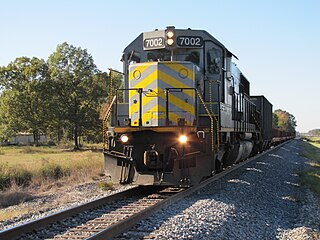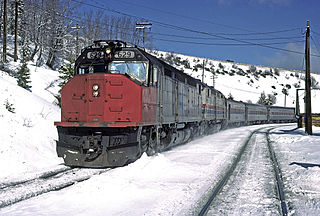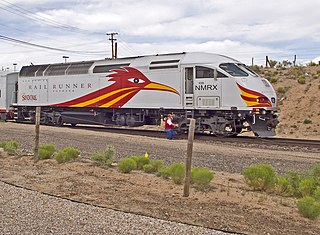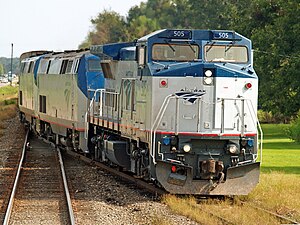
The EMD AEM-7 is a twin-cab four-axle 7,000 hp (5.2 MW) B-B electric locomotive built by Electro-Motive Division (EMD) and ASEA between 1978 and 1988. The locomotive is a derivative of the Swedish SJ Rc4 designed for passenger service in the United States. The primary customer was Amtrak, which bought 54 for use on the Northeast Corridor and Keystone Corridor. Two commuter operators, MARC and SEPTA, also purchased locomotives, for a total of 65.

The GE Genesis is a series of passenger diesel locomotives built by GE Transportation for Amtrak, Metro-North, and Via Rail between 1992 and 2001. A total of 321 units were produced.

A cowl unit is a diesel locomotive with full-width, enclosing bodywork, similar in appearance to the cab unit-style of earlier locomotives, such as the EMD F-units of the 1940s and 1950s. The term cowl unit is of North American origin, although similarly-styled locomotives exist elsewhere.

The EMD F40PH is a four-axle 3,000–3,200 hp (2.2–2.4 MW) B-B diesel-electric locomotive built by General Motors Electro-Motive Division in several variants from 1975 to 1992. Intended for use on Amtrak's short-haul passenger routes, it became the backbone of Amtrak's diesel fleet after the failure of the EMD SDP40F. The F40PH also found widespread use on commuter railroads in the United States and with VIA Rail in Canada. Additional F40PH variants were manufactured by Morrison-Knudsen and MotivePower between 1988 and 1998, mostly rebuilt from older locomotives.

The E9 is a 2,400-horsepower (1,790 kW), A1A-A1A passenger train-hauling diesel locomotive built by General Motors' Electro-Motive Division of La Grange, Illinois, between April 1954 and January 1964. 100 cab-equipped A units were produced and 44 cabless booster B units, all for service in the United States. The E9 was the tenth and last model of EMD E-unit and differed from the earlier E8 as built only by the newer engines and a different, flusher-fitting mounting for the headlight glass, the latter being the only visible difference. Since some E8s were fitted with this, it is not a reliable way to distinguish the two. The E9 has two 1,200 hp (895 kW), V12 model 567C engines, each engine driving one generator to power two traction motors.

The GE C44-9W is a 4,400 hp (3,281 kW) diesel-electric locomotive built by GE Transportation Systems of Erie, Pennsylvania. Keeping in tradition with GE's locomotive series nicknames beginning with the "Dash 7" of the 1970s, the C44-9W was dubbed the Dash 9 upon its debut in 1993.

The EMD SD50 is a 3,500-horsepower (2,610 kW) diesel-electric locomotive built by General Motors Electro-Motive Division. It was introduced in May 1981 as part of EMD's "50 Series"; production ceased in January 1986. The SD50 was a transitional model between EMD's Dash 2 series which was produced throughout the 1970s and the microprocessor-equipped SD60 and SD70 locomotives. A total of 431 were built.

In rail transport, head-end power (HEP), also known as electric train supply (ETS), is the electrical power distribution system on a passenger train. The power source, usually a locomotive at the front or 'head' of a train, provides the electricity used for heating, lighting, electrical and other 'hotel' needs. The maritime equivalent is hotel electric power. A successful attempt by the London, Brighton and South Coast Railway in October 1881 to light the passenger cars on the London to Brighton route heralded the beginning of using electricity to light trains in the world.

An SDP40 is a 6-axle passenger diesel-electric locomotive built by General Motors Electro-Motive Division (EMD) between June 1966 and May 1970.

The EMD SDP40F was a six-axle 3,000 hp (2.2 MW) C-C diesel–electric locomotive built by General Motors Electro-Motive Division (EMD) from 1973 to 1974. Based on Santa Fe's EMD FP45, EMD built 150 for Amtrak, the operator of most intercity passenger trains in the United States. Amtrak, a private company but funded by the United States government, had begun operation in 1971 with a fleet of aging diesel locomotives inherited from various private railroads. The SDP40F was the first diesel locomotive built new for Amtrak and for a brief time they formed the backbone of the company's long-distance fleet.

The GE Dash 8-32B is a 4-axle 3,150 hp (2,350 kW) diesel-electric locomotive built by GE Transportation between 1984 and 1989. It is part of the GE Dash 8 Series of freight locomotives.

The passenger locomotives derivatives of the General Motors EMD GP40 diesel-electric locomotive have been, and continue to be, used by multiple passenger railroads in North America. For passenger service, the locomotives required extra components for providing steam or head-end power (HEP) for heating, lighting and electricity in passenger cars. Most of these passenger locomotives were rebuilt from older freight locomotives, while some were built as brand new models.

The MPI MPXpress is a line of diesel-electric locomotives built by MotivePower for commuter rail service. There are five MPXpress models: MP36PH-3S, MP36PH-3C, MP40PH-3C, MP32PH-Q, and MP54AC.

The GE P30CH was one of the first brand-new diesel-electric locomotives built for Amtrak by General Electric during Amtrak's early years. The design was based on the GE U30C, but had a cowl carbody like its EMD competitors. Amtrak operated them between 1975 and 1992.

The GE E60 is a family of six-axle 6,000 hp (4.5 MW) C-C electric locomotives made by GE Transportation Systems (GE) between 1972 and 1983. The E60s were produced in several variants for both freight and passenger use in the United States and Mexico. GE designed the locomotive for use on the Black Mesa and Lake Powell Railroad (BM&LP), a dedicated coal-hauling route in Arizona, which began operation in 1973. That same year GE adapted the design for high-speed passenger service on Amtrak's Northeast Corridor. The largest customer was Ferrocarriles Nacionales de México (NdeM), the state-owned railroad in Mexico, which bought 39 for a new electrification project in the early 1980s.

The Dash 7 Series is a line of diesel-electric freight locomotives built by GE Transportation. It replaced the Universal Series in the mid-1970s, and was superseded by the Dash 8 Series in the mid-1980s.

The Dash 8 Series is a line of diesel-electric freight locomotives built by GE Transportation. It replaced the Dash 7 Series in the mid-1980s, and was superseded by the Dash 9 Series for freight usage and the Genesis Series for passenger usage in the mid-1990s.

The Siemens Charger is a family of diesel-electric/dual-mode passenger locomotives designed and manufactured by Siemens Mobility for the North American market.




















